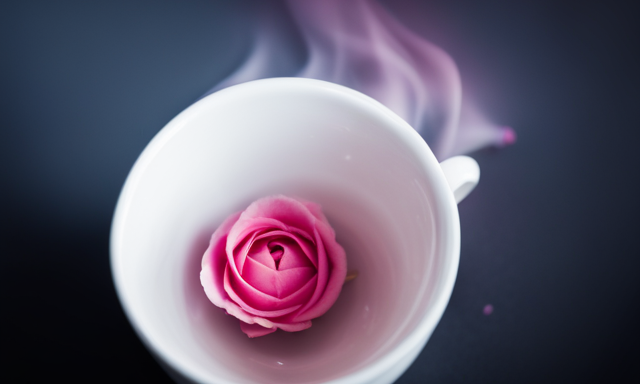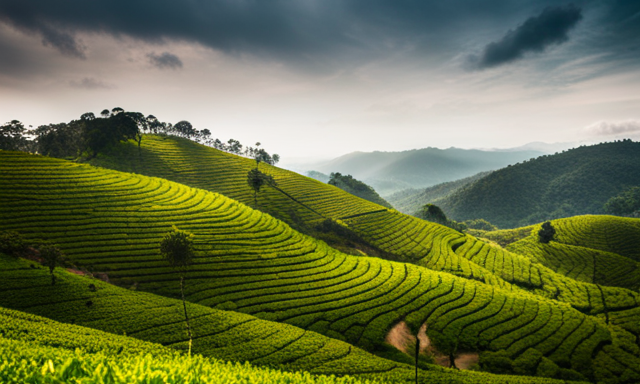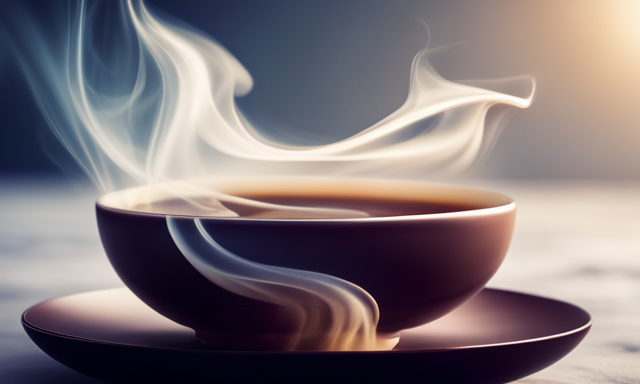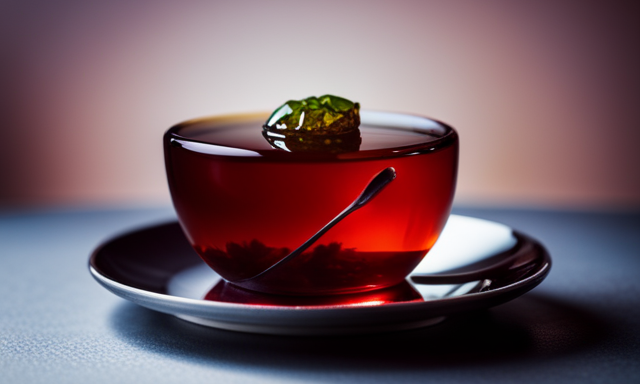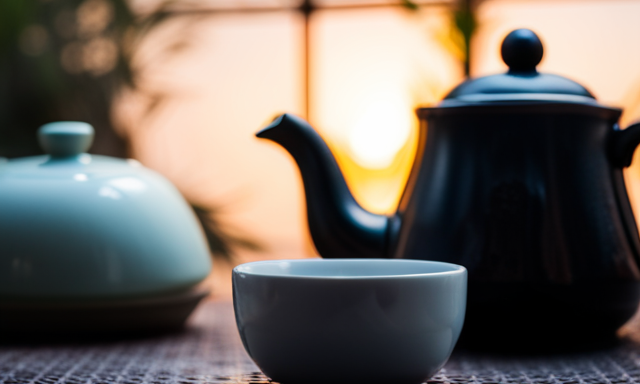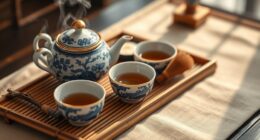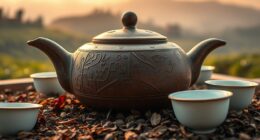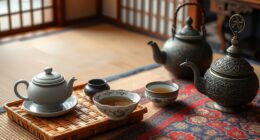You might think that all teas taste the same, but let me tell you, rose oolong tea is in a league of its own. This exquisite blend combines the delicate floral notes of rose petals with the rich, earthy flavors of oolong tea, creating a truly exceptional beverage.
As a tea enthusiast, I have explored a wide range of tea varieties, but rose oolong has quickly become one of my favorites.
Originating from the mountains of Taiwan, rose oolong tea is crafted with meticulous care. The tea leaves are hand-picked and skillfully processed, allowing the flavors to develop and intertwine with the essence of the rose petals. The result is a tea that is both fragrant and complex, with a smooth and slightly sweet taste.
Not only does rose oolong tea offer a delightful sensory experience, but it also boasts numerous health benefits. From boosting metabolism to promoting relaxation, this tea is a true gift from nature.
In this article, we will delve into the world of rose oolong tea, exploring its origin, making process, flavor profile, and health benefits. I will also provide tips on how to brew the perfect cup and where to find this exceptional tea.
So, grab your teacup and join me on this aromatic journey through the world of rose oolong tea.
Key Takeaways
- Rose oolong tea is a unique blend of rose petals and oolong tea that originates from Taiwan and has cultural significance in Taiwanese tea culture.
- Rose oolong tea offers numerous health benefits, including boosting immunity, promoting relaxation, supporting digestion, aiding in weight management, and having antioxidant properties.
- Brewing rose oolong tea is a simple and enjoyable process, with an ideal brewing temperature of 185°F (85°C) and a steeping time of 3-5 minutes.
- Rose oolong tea has cultural significance in Asian cultures, symbolizing love, beauty, and purity, and it can be stored in airtight containers in cool, dark places for up to two years.
The Origin of Rose Oolong Tea
Imagine yourself walking through the lush fields of Taiwan, where the delicate petals of fragrant roses are carefully blended with rich oolong tea leaves, creating a symphony of floral flavors in every sip.
The history of rose oolong tea dates back centuries, originating in the Fujian province of China and later brought to Taiwan. It has since become an integral part of Taiwanese tea culture, with its cultural significance stemming from its soothing aroma and unique taste.
The combination of rose petals and oolong tea leaves creates a harmonious balance, resulting in a tea that’s both smooth and refreshing, with a hint of sweetness.
As you continue on this journey, let’s delve into the fascinating process of how this remarkable tea is made.
The Making Process of Rose Oolong Tea
To fully understand the captivating process of crafting this exquisite blend, picture yourself in a world where petals and leaves intertwine, creating a sensory symphony that dances upon your taste buds.
The making process of rose oolong tea begins with the careful selection of high-quality tea leaves, which are then infused with the delicate aroma of rose petals. The petals are meticulously handpicked, ensuring their freshness and fragrance.
As the leaves and petals are gently combined, they undergo a meticulous drying process that preserves the natural flavors and aromas. This process allows the tea to absorb the enchanting scent of the roses, creating a harmonious fusion of floral and earthy notes. The health benefits of rose petals, such as their rich antioxidants and soothing properties, further enhance the tea’s allure.
Transitioning into the subsequent section about the flavor profile of rose oolong tea, one can anticipate a symphony of flavors that’ll delight the senses.
The Flavor Profile of Rose Oolong Tea
When it comes to the flavor profile of rose oolong tea, there are two key aspects to consider: the floral aromas and tastes from the rose petals, and the rich and complex flavors of oolong tea itself.
The infusion of rose petals brings a delicate and fragrant floral note to the tea, adding a touch of elegance and sophistication. At the same time, the oolong tea base provides a robust and full-bodied taste with hints of fruit and a slightly creamy texture.
Together, these elements create a harmonious and captivating flavor experience that’s sure to delight any tea enthusiast.
Floral Aromas and Tastes from Rose Petals
Indulge in the delightful bouquet of rose oolong tea, where the delicate essence of rose petals dances on your palate like a fragrant symphony. This exquisite tea not only offers a sensory experience but also comes with numerous benefits.
- Rose Oolong Tea Benefits:
- Boosts Immunity: Packed with antioxidants, rose oolong tea helps strengthen the immune system, protecting against illnesses.
- Promotes Relaxation: The floral aroma of rose petals in this tea has a calming effect, reducing stress and promoting relaxation.
- Supports Digestion: Rose oolong tea aids digestion by soothing the stomach and relieving bloating and discomfort.
Apart from its health benefits, rose oolong tea can also be used in various recipes, from refreshing iced tea to floral-infused desserts. With its rich and complex flavors, oolong tea offers a perfect complement to the delicate floral notes of roses.
Transitioning to the next section, let’s explore the captivating world of oolong tea’s rich and complex flavors.
Rich and Complex Flavors of Oolong Tea
Immerse yourself in a world of sensory delight as you savor the rich and complex flavors of this exquisite beverage. Rose oolong tea offers flavorful infusions that are truly a treat for the taste buds.
The oolong tea leaves, with their partial oxidation, create a unique flavor profile that lies somewhere between black and green tea. This results in a tea that’s smooth, floral, and slightly sweet, with hints of fruit and honey. The addition of rose petals further enhances the taste experience, adding a delicate floral note that complements the oolong perfectly.
To fully appreciate the flavors of rose oolong tea, it’s important to use the right brewing techniques. Steep the tea leaves at a lower temperature for a shorter time to ensure a well-balanced and aromatic cup.
Transitioning into the next section about the health benefits of rose oolong tea, the flavorful infusions also offer a range of potential health benefits.
Health Benefits of Rose Oolong Tea
Rose oolong tea offers a range of health benefits that make it a delightful addition to my daily routine. It has antioxidant properties that support my immune system and help protect my body against harmful free radicals. Additionally, it acts as a digestive aid, soothing my stomach and promoting healthy digestion. It also aids in weight management by boosting my metabolism.
Antioxidant Properties and Immune Support
Boost your immune system with the antioxidant-rich properties of rose oolong tea, a delightful blend that’s like a shield of strength for your body. The antioxidants found in rose oolong tea provide numerous benefits for your health. These powerful compounds help to neutralize harmful free radicals in the body, reducing oxidative stress and inflammation. By doing so, they support the immune system and protect against various diseases.
Furthermore, the antioxidants in rose oolong tea promote the production of white blood cells, which are essential for fighting off infections and boosting overall immunity. So, by regularly consuming rose oolong tea, you can give your immune system the support it needs to stay strong and healthy.
Moving on to the next section about digestive aid and weight management, let’s explore how rose oolong tea can assist with these aspects of your health.
Digestive Aid and Weight Management
To improve digestion and manage your weight more effectively, try incorporating the digestive aid and weight management benefits of rose oolong tea into your daily routine. Rose oolong tea has been known for its positive effects on digestive health, as it helps to soothe the stomach and alleviate indigestion.
The natural compounds found in rose oolong tea can also promote healthy digestion by stimulating the production of digestive enzymes. Additionally, this tea has been shown to aid in weight management by boosting metabolism and promoting fat oxidation. The combination of its natural properties and mild caffeine content make rose oolong tea a great option for those looking to achieve natural weight loss.
So, let’s continue exploring the benefits of rose oolong tea by learning how to brew it properly.
How to Brew Rose Oolong Tea
Brewing a delicious cup of rose oolong tea is a simple and enjoyable process that’ll leave you feeling refreshed and relaxed.
To bring out the delicate flavors and aromas of this exquisite tea, it’s important to use the right brewing techniques and temperature. Start by heating water to around 185°F (85°C), as that’s the best brewing temperature for oolong tea.
Then, place one teaspoon of rose oolong tea leaves in a teapot or infuser. Pour the hot water over the leaves and let it steep for about 3-5 minutes. This allows the flavors to infuse into the water, creating a fragrant and flavorful cup of tea.
Once brewed, strain the tea and it’s ready to be enjoyed.
Now, let’s explore the perfect food pairings that complement the unique taste of rose oolong tea.
Pairing Rose Oolong Tea with Food
Now that you know how to brew a perfect cup of rose oolong tea, let’s talk about the delightful experience of pairing it with food.
The combination of the floral aroma and delicate flavor of rose oolong tea makes it a wonderful accompaniment to desserts. Whether you’re enjoying a slice of rich chocolate cake or a light and fruity tart, the subtle sweetness of the tea complements the sweetness of the dessert, creating a harmonious balance of flavors.
In addition to its culinary appeal, rose oolong tea also holds cultural significance. In many Asian cultures, roses symbolize love, beauty, and purity, making rose oolong tea a popular choice for special occasions and celebrations.
Now, let’s explore the different popular varieties of rose oolong tea and discover their unique characteristics.
Popular Varieties of Rose Oolong Tea
When it comes to popular varieties of rose oolong tea, two standout options are Traditional Taiwanese Rose Oolong and Chinese Rose Oolong Blends.
The Traditional Taiwanese Rose Oolong is known for its delicate floral aroma and smooth taste, making it a favorite among tea enthusiasts.
On the other hand, Chinese Rose Oolong Blends offer a unique combination of oolong tea leaves and dried rose petals, creating a rich and fragrant brew that is both soothing and invigorating.
Traditional Taiwanese Rose Oolong
Aromatic and delicate, traditional Taiwanese Rose Oolong is a captivating blend of floral rose petals and rich oolong tea leaves, creating a harmonious infusion that transports you to the enchanting tea gardens of Taiwan. This tea has a fascinating history and holds great cultural significance. Rose oolong tea originated in Taiwan, where it has been cultivated and enjoyed for centuries. The combination of rose petals and oolong tea leaves creates a unique flavor profile that is both floral and earthy. The tea is carefully harvested and processed, with the rose petals being layered with the tea leaves to allow for their fragrant oils to infuse into the tea. The resulting brew is a beautiful golden color with a subtle rose aroma and a smooth, slightly sweet taste. This traditional Taiwanese Rose Oolong is a true delight for tea lovers, offering a sensory experience that is both soothing and invigorating. Now, let’s explore the next section about Chinese Rose Oolong blends.
Chinese Rose Oolong Blends
Indulge yourself in the captivating allure of Chinese Rose Oolong blends, transporting your senses to a floral paradise that will leave you craving for more.
Chinese Rose Oolong blends combine the delicate flavors of tea with the fragrant essence of roses, creating a harmonious and enchanting experience. These blends are crafted by expert tea artisans who carefully select the finest tea leaves and infuse them with the natural sweetness of rose petals.
Not only do these blends offer a delightful taste, but they also provide numerous health benefits. Rose oolong tea is known for its antioxidant properties, promoting heart health, aiding digestion, and reducing stress.
With its delicate floral aroma and numerous health benefits, Chinese Rose Oolong blends are a must-try for tea enthusiasts.
Now, let’s explore where to buy this exquisite tea.
Where to Buy Rose Oolong Tea
To find where you can buy rose oolong tea, check out local tea shops or specialty stores near you. Rose oolong tea is gaining popularity due to its unique flavor and the benefits it offers.
This tea is known for its delicate floral aroma and the perfect balance between the floral notes of rose petals and the rich, earthy taste of oolong tea. Drinking rose oolong tea not only provides a soothing and relaxing experience but also offers numerous health benefits. It’s believed to boost digestion, promote weight loss, and improve skin health.
In addition to its health benefits, rose oolong tea holds cultural significance in Chinese traditions. It is often enjoyed during special occasions and ceremonies.
Now let’s move on to the next section about storing and preserving rose oolong tea.
Storing and Preserving Rose Oolong Tea
When it comes to storing and preserving rose oolong tea, it’s important to consider the proper storage containers and conditions. Airtight containers, such as glass jars or tins, are ideal for keeping the tea fresh and preventing it from absorbing any unwanted odors.
Additionally, the tea should be stored in a cool and dark place, away from direct sunlight or heat sources, to maintain its flavor and aroma. In terms of shelf life, rose oolong tea can typically be stored for up to two years, but it’s recommended to consume it within a year for optimal freshness.
To ensure the tea stays fresh, it’s advisable to keep it away from moisture and strong odors, and to seal the container tightly after each use.
Proper Storage Containers and Conditions
Store your rose oolong tea in airtight containers to preserve its delicate flavors and aromas. The storing conditions and choice of container are crucial in maintaining the quality of your tea. Opt for containers made of glass or ceramic, as they’re non-reactive and don’t absorb odors. Avoid using plastic containers, as they can alter the taste of the tea.
Make sure the containers are completely airtight to prevent moisture and air from seeping in. Store the tea in a cool, dry place away from direct sunlight and strong odors. This will help to retain its freshness and prevent any degradation in flavor.
Proper storage is essential for maintaining the integrity of your rose oolong tea, ensuring a delightful cup every time.
Now let’s explore how to extend the shelf life and freshness of your tea.
Shelf Life and Freshness Maintenance
When it comes to properly storing rose oolong tea, it’s essential to consider the shelf life preservation and freshness maintenance.
To ensure the tea’s longevity and flavor profile, it’s recommended to store it in airtight containers away from light, heat, and moisture. This helps to prevent oxidation and maintain its delicate aroma and taste.
Additionally, it’s crucial to follow the best brewing techniques to fully enjoy the tea’s unique characteristics. Brewing rose oolong tea at the right temperature and steeping it for the appropriate duration allows the flavors to blossom and the floral notes to shine.
By paying attention to the storage conditions and brewing methods, you can savor the freshness and complexity of rose oolong tea with every sip.
Now, let’s delve into the fascinating world of tea blends.
Exploring the World of Tea Blends
When it comes to exploring the world of tea blends, I love experimenting with different combinations of tea and flowers.
One combination that has particularly caught my attention is the blend of rose oolong tea. The delicate floral notes of the rose petals complement the rich, smooth flavor of the oolong tea, creating a unique and delightful taste experience.
I’ve also taken it a step further by creating my own unique rose oolong tea blend, combining different varieties of roses with different oolong teas to create a personalized and exquisite blend.
Experimenting with Other Tea and Flower Combinations
Try blending rose petals with oolong tea for a captivating and aromatic experience that’ll transport you to a serene garden oasis.
When experimenting with different tea and fruit combinations, it’s important to explore the benefits of herbal infusions. Rose petals add a delicate floral note to the rich and earthy flavor of oolong tea, creating a harmonious blend that’s both soothing and invigorating.
The combination of these two ingredients not only enhances the taste but also offers numerous health benefits. Rose petals are known for their calming properties and their ability to promote relaxation and reduce stress. Oolong tea, on the other hand, contains antioxidants that may help boost metabolism and support weight management.
So why not create your own unique rose oolong tea blend and embark on a journey of delightful flavors and wellness?
Let’s dive into the next section to learn how to do it.
Creating Your Own Unique Rose Oolong Tea Blend
After experimenting with various tea and flower combinations, I’ve discovered a newfound passion for creating my own unique rose oolong tea blend. The process of blending different flavors and aromas is truly an art form that allows me to create a tea that’s perfectly suited to my tastes.
Creating unique tea flavors isn’t just enjoyable, but it also offers a multitude of benefits. Floral teas, like rose oolong, not only have a delightful and fragrant taste, but they also offer numerous health benefits. The combination of the delicate oolong tea leaves and the subtle floral notes of rose creates a harmonious and soothing beverage.
Rose oolong tea is known for its ability to promote relaxation, reduce stress, and improve digestion. It’s also rich in antioxidants, which can help boost the immune system and protect against free radicals.
Incorporating floral teas into your daily routine is a wonderful way to enhance your overall well-being and indulge in the beauty of nature’s flavors.
Frequently Asked Questions
Is rose oolong tea caffeine-free?
No, rose oolong tea is not caffeine-free. However, it can be mixed with other herbs to enhance its flavor. It is important to note that rose oolong tea contains natural caffeine from the oolong tea leaves.
Can rose oolong tea be enjoyed both hot and cold?
Yes, rose oolong tea can be enjoyed both hot and cold. When I first tasted the hot rose oolong, it was like a warm embrace, while the cold rose oolong was refreshing, like a cool breeze on a summer day.
Does rose oolong tea have any side effects?
Rose oolong tea, like any other tea, may have potential allergies for some individuals. However, when consumed in moderation, there are no known long-term effects. It is always advisable to consult a healthcare professional if you have any concerns.
What is the recommended steeping time for rose oolong tea?
The recommended steeping time for rose oolong tea is 3-5 minutes. This allows for the perfect balance of flavors to develop. In addition to its delightful taste, rose oolong tea offers numerous health benefits, such as promoting digestion and boosting the immune system.
Can rose oolong tea be infused multiple times?
Yes, rose oolong tea can be infused multiple times, making it a cost-effective choice. Each infusion brings out a unique flavor profile, ranging from delicate floral notes to rich, earthy flavors. Additionally, it offers numerous health benefits like promoting digestion and boosting the immune system.
Conclusion
In conclusion, Rose Oolong tea is a delightful blend of flavors and aromas that take you on a journey through time and nature. With its origins rooted in ancient traditions, this tea offers a unique and exquisite taste that’s both soothing and invigorating. Its delicate floral notes and velvety texture will transport you to a peaceful garden, where the fragrance of blooming roses fills the air.
So, take a sip and let your senses bloom like a garden in full blossom.

